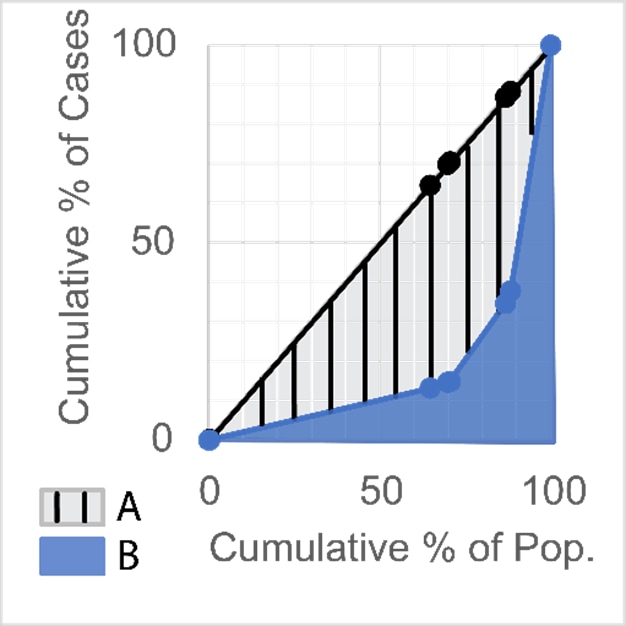
Health Disparity Measures
Measuring health disparities is essential for informing targeted efforts to reduce disparities. Health disparities can be measured between racial or ethnic groups, geographic regions, gender identities, socioeconomic statuses, or other group statuses (e.g., migrant or refugee status, experience of homelessness, incarceration). Changes in measures over time can indicate progress or setbacks in eliminating health disparities. Different disparity measures can provide different results in magnitude and direction.1-6 The measures described in this document represent a subset of commonly used measures in public health.2,4-5,7 No gold standard measure exists, so the literature recommends measuring disparities in both absolute and relative terms to help ensure robustness of findings.1-2,4
Pairwise measures show disparities between two groups. Examples of pairwise measures include:5,8-9
Absolute Rate Difference
𝑅𝑎𝑡𝑒1 − 𝑅𝑎𝑡𝑒2
Group 2 is the comparison group, such as the group with the lowest rate.
Knowing the direction (positive or negative) of the rate difference is also important.
Rate Ratio
𝑅𝑎𝑡𝑒1
𝑅𝑎𝑡𝑒2
Group 2 is the comparison group, such as the group with the lowest rate.
If Rate1 > Rate2, the rate ratio will be greater than 1.
If Rate1 = Rate2, the rate ratio will be equal to 1.
If Rate1 < Rate2, the rate ratio will be less than 1.
Composite measures show disparities in a whole population. Examples of composite measures include:
Population Attributable Proportion (PAP)2,8,10
This is the proportion of cases attributable to disparities between groups.

Rateoverall is the rate in the total population.
Ratelowest is the rate in the group with the lowest rate (i.e. the comparison group).
If Ratelowest = 0, all cases are attributable to disparities, and the PAP will equal 1.
If Rateoverall = Ratelowest, no cases are attributable to disparities, and the PAP will equal 0.
Absolute and Relative Indices of Disparity5,8,10-11
Index of Disparity
0 = No disparity; higher values indicate greater disparity.

Ratei is the rate in group i.
Rateoverall is the rate in the total population.
N is the total number of groups.
Population-Weighted Index of Disparity*
This index of disparity is weighted by the population size of each group.

Populationi is the number of people in group i.
Populationoverall is the total number of people, equaling the sum of all Populationi.
*There are equity considerations to account for when deciding whether to weight measures or not.4,12
Gini Coefficient7-8,10,13
0 = No disparity; 1 = maximum disparity

Groups are ranked from 1 to N by their rates.
Xi is the cumulative percentage of the population after including group i.
Yi is the cumulative percentage of cases/diagnoses after including group i.
X0 and Y0 are both 0.
N is the total number of groups.

The blue line plots Xi and Yi from the table below. The black line shows the hypothetical situation of no disparity, where each group’s share of cases equals their share of the population. The Gini Coefficient would equal 0.
| Group | Cases | Rate | Population | Cumulative % of Pop. (Xi) | Cumulative % of Cases (Yi) |
|---|---|---|---|---|---|
| Native Hawaiian/Other Pacific Islander | 1 | 0.5 | 213,000 | 0.2 | 0.03 |
| White | 425 | 0.5 | 80,189,000 | 64.6 | 13.1 |
| Asian | 48 | 0.8 | 6,400,000 | 69.8 | 14.6 |
| American Indian/Alaska Native | 10 | 1.1 | 901,000 | 70.5 | 14.9 |
| Hispanic/Latino | 644 | 3.2 | 20,252,000 | 86.7 | 34.7 |
| Multiple Races | 99 | 5.2 | 1,908,000 | 88.3 | 37.7 |
| Black/African American | 2027 | 13.9 | 14,583,000 | 100.0 | 100.0 |
| Total | 3254 | 2.6 | 124,446,000 | 100.0 | 100.0 |
The Gini Coefficient is also equal to A/(A+B). The larger the gap (area A) between the no disparity line (in black) and the actual data (in blue), the greater the disparities in the total population.
References
1. Keppel et al. 2005. Vital Health Stat. 2. Regidor 2004b. J Epidemiol Community Health. 3. Anand et al. 2001. Oxford University Press. 4. Harper et al. 2010. Milbank Q. 5. Harper et al. 2008. Am J Epidemiol. 6. Moonesinghe et al. 2017. Epidemiology. 7. Regidor 2004a. J Epidemiol Community Health. 8. McCree et al. 2020. AIDS and Behavior. 9. Sekikawa and Kuller. 2004. J Womens Health Gend Based Med. 10. Chesson et al. 2018. Sex Transm Dis. 11. Pearcy and Keppel. 2002. Public Health Reports. 12. Penman-Aguilar et al. 2016. J Public Health Manag Pract. 13. McCree et al. 2020. JAIDS.
This fact sheet was prepared by Joy Ortega (CDC/IOD/OS), Kristy Hayes (CDC/GHC/OD), Donna Hubbard McCree (CDC/NCHHSTP/OD), Harrell Chesson (CDC/NCHHSTP/DSTDP), and Ranell Myles (CDC/NCHHSTP/OD).
Materials listed in these guides are selected to provide awareness of quality public health literature and resources. A material’s inclusion does not necessarily represent the views of the U.S. Department of Health and Human Services (HHS), the Public Health Service (PHS), or the Centers for Disease Control and Prevention (CDC), nor does it imply endorsement of the material’s methods or findings. HHS, PHS, and CDC assume no responsibility for the factual accuracy of the items presented. The selection, omission, or content of items does not imply any endorsement or other position taken by HHS, PHS, and CDC. Opinion, findings, and conclusions expressed by the original authors of items included in these materials, or persons quoted therein, are strictly their own and are in no way meant to represent the opinion or views of HHS, PHS, or CDC. References to publications, news sources, and non-CDC Websites are provided solely for informational purposes and do not imply endorsement by HHS, PHS, or CDC.